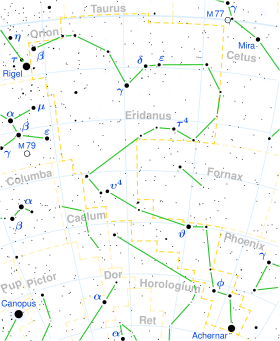HD 10647
HD 10647 (q1 Eridani) is a 6th-magnitude yellow-white dwarf star, 57 light-years away in the constellation of Eridanus. The star is visible to the unaided eye under very dark skies. It is slightly hotter and more luminous than the Sun, and at 1,750 million years old, it is also younger. An extrasolar planet was discovered orbiting this star in 2003.
 | |
| Observation data Epoch J2000.0 Equinox J2000.0 | |
|---|---|
| Constellation | Eridanus |
| Right ascension | 01h 42m 29.3149s[1] |
| Declination | –53° 44′ 26.9912″[1] |
| Apparent magnitude (V) | 5.52[2] |
| Characteristics | |
| Spectral type | F9V[3] |
| B−V color index | 0.551[2] |
| Astrometry | |
| Radial velocity (Rv) | 12.9 km/s |
| Proper motion (μ) | RA: 165.832±0.099[1] mas/yr Dec.: −105.515±0.097[1] mas/yr |
| Parallax (π) | 57.6556 ± 0.0737[1] mas |
| Distance | 56.57 ± 0.07 ly (17.34 ± 0.02 pc) |
| Absolute magnitude (MV) | 4.32 |
| Details | |
| Mass | 1.11 ± 0.02[3] M☉ |
| Radius | 1.10 ± 0.02[3] R☉ |
| Luminosity | 1.41[3] L☉ |
| Temperature | 6218 ± 20[3] K |
| Metallicity [Fe/H] | 0.00 ± 0.01[3] dex |
| Rotation | 10 ± 3[3] |
| Rotational velocity (v sin i) | 4.9[3] km/s |
| Age | 1.4 ± 0.9[3] Gyr |
| Other designations | |
| Database references | |
| SIMBAD | data |
| Extrasolar Planets Encyclopaedia | data |
Planetary system
In 2003, Michel Mayor's team announced the discovery of a new planet, HD 10647 b, in Paris at the XIX IAP Colloquium Extrasolar Planets: Today & Tormorrow* . The Anglo-Australian Planet Search team initially did not detect the planet in 2004,[4] though a solution was made by 2006.[5] The CORALIE data was finally published in 2013.[3]
The IRAS infrared space telescope detected an excess of infrared radiation from the star, indicating a possible circumstellar disk.[6] Using this data and later observations with the Spitzer Space Telescope, Infrared Space Observatory and the Atacama Pathfinder Experiment implies that the disk is located at 25 Astronomical units and has a thin (0.02 AU), ring-like structure, with the sharp cutoff in the disk suggesting a planet.[7] Additionally, a much longer wavelength suggests the existence of a much wider belt of material, analogous to the Kuiper belt. The hierarchy of this system is somewhat reminiscent of that of Epsilon Eridani, without an inner asteroid belt.
| Companion (in order from star) |
Mass | Semimajor axis (AU) |
Orbital period (days) |
Eccentricity | Inclination | Radius |
|---|---|---|---|---|---|---|
| b | >0.94 ± 0.08 MJ | 2.015 ± 0.011 | 989.2 ± 8.1 | 0.15 ± 0.08 | — | — |
| Dust disk | 25 AU | — | — | |||
| Dust disk | 270–330 AU | — | — | |||
References
- Brown, A. G. A.; et al. (Gaia collaboration) (August 2018). "Gaia Data Release 2: Summary of the contents and survey properties". Astronomy & Astrophysics. 616. A1. arXiv:1804.09365. Bibcode:2018A&A...616A...1G. doi:10.1051/0004-6361/201833051. Gaia DR2 record for this source at VizieR.
- Decin, G.; et al. (November 2003), "Age Dependence of the Vega Phenomenon: Observations", The Astrophysical Journal, 598 (1): 636–644, arXiv:astro-ph/0308294, Bibcode:2003ApJ...598..636D, doi:10.1086/378800
- Marmier, M.; et al. (2013). "The CORALIE survey for southern extrasolar planets XVII. New and updated long period and massive planets". Astronomy and Astrophysics. 551. A90. arXiv:1211.6444. Bibcode:2013A&A...551A..90M. doi:10.1051/0004-6361/201219639.
- Jones, H. R. A.; et al. (2004). "HD10647 and the Distribution of Exoplanet Properties with Semi-major Axis". Extrasolar Planets: Today and Tomorrow. 321: 298. Bibcode:2004ASPC..321..298J.
- Butler, R. P.; et al. (2006). "Catalog of Nearby Exoplanets". The Astrophysical Journal. 646 (1): 505–522. arXiv:astro-ph/0607493. Bibcode:2006ApJ...646..505B. doi:10.1086/504701.
- Stencel and Backman; Backman, Dana E. (1991). "A survey for infrared excesses among high galactic latitude SAO stars". The Astrophysical Journal Supplement Series. 75: 905–924. Bibcode:1991ApJS...75..905S. doi:10.1086/191553.
- Liseau; et al. (2008). "q1 Eridani: a solar-type star with a planet and a dust belt". Astronomy and Astrophysics Letters. 480 (3): L47–L50. arXiv:0803.1294. Bibcode:2008A&A...480L..47L. doi:10.1051/0004-6361:20079276.
External links
- "A Jovian planet around HD 10647". Geneva Observatory.
- "HD 10647 / HR 506 / CP(D)-54 365 (q1 Eridani)". SolStation. Retrieved 2008-06-12.